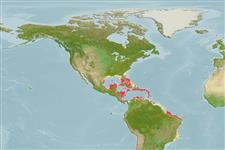Common names from other countries
Environment: milieu / climate zone / depth range / distribution range
Ecologia
Associadas(os) a recifes; estuarina; intervalo de profundidade 0 - 69 m (Ref. 415). Tropical
Western Atlantic.
Length at first maturity / Tamanho / Peso / Idade
Maturity: Lm ? range ? - ? cm Max length : 250 cm WD macho/indeterminado; (Ref. 99323)
Barrel shaped, with thick walls. Purple to red brown externally, tan internally. Surface with protuberances with round or blade-like outlines. Brittle and crumbly in consistency. Oscules on the inner side of vase; 0.2 - 0.3 cm (Ref. 415).
Maximum depth reported taken from Ref. 128739.. Maximum length refers to base diameter (Ref. 99323). Common on reef environments (Ref. 415). Also found in mangroves (Ref. 86836). Inhabits shallow coral reefs, coral communities, coralline algae reefs, algal nodules, and mesophotic reefs (Ref. 128739).
Life cycle and mating behavior
Maturidade | Reprodução | Desova | Ovos | Fecundidade | Larvas
Broadcast spawner.
Collin, R., M.C. Díaz, J. Norenburg, R.M. Rocha, J.A. Sánchez, M. Schulze, A. Schwartz and A. Valdés. 2005. (Ref. 415)
Status na Lista Vermelha da IUCN (Ref. 130435)
Status no CITES (Ref. 108899)
Not Evaluated
Not Evaluated
Uso pelos humanos
| FishSource |
Ferramentas
Fontes da internet
Estimates based on models
Preferred temperature
(Ref.
115969): 26.4 - 28.2, mean 27.5 (based on 519 cells).
Resiliência
Muito baixo, tempo mínimo de duplicação da população maior que 14 anos (K=0.04).
Categoria de preço
Unknown.
